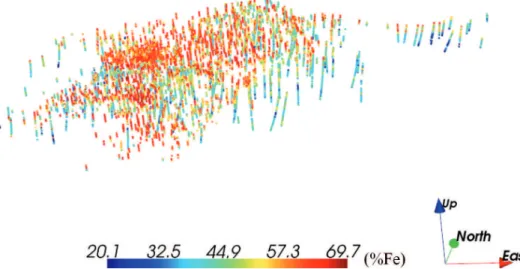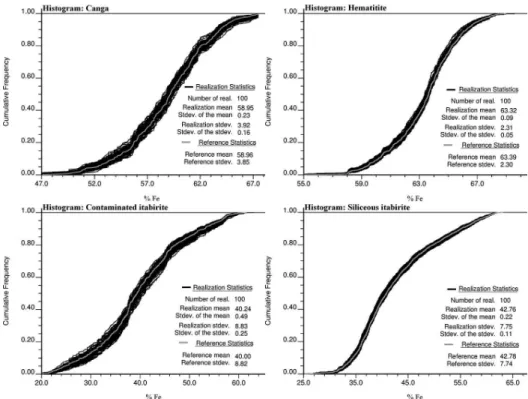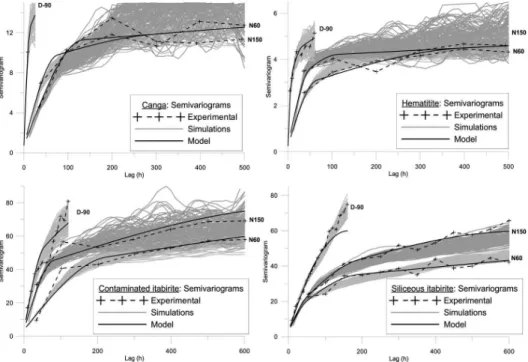Abstract
Geostatistical simulation comprises a variety of techniques which can help on the decision-making process for uncertainties. They allow the uncertainty assessment of func-tion responses (which depend on the simulated inputs) commonly through a non-linear relationship (net present value, interest tax return, geometallurgical ore recovery…). How-ever, one of their limitations is that running the simulation can take considerable process-ing time to be executed in large deposits or large grids. Herein is presented an attempt to solve this problem in short-term modeling cases, via the use of Multiple Random Walk Simulation. This algorithm combines kriging with the simulation of independent random walks in order to generate simulated scenarios much faster than via traditional simulation algorithms. A case study is presented to illustrate the application of the method in an iron mine. The Multiple Random Walk Simulation models were properly built, respecting the reproduction of both histogram and variograms. Also, the speed-up was compared with standard methods of geostatistical simulation and there was a considerable speed gain with Multiple Random Walk Simulation (3.39 to 5.65 times faster than the others).
Keywords: geostatistics; conditional simulation; mining; short-term modeling.
Rafael Moniz Caixeta
Doutorando
Universidade Federal do Rio Grande do Sul - UFRS Departamento de Engenharia de Minas Porto Alegre – Rio Grande do Sul - Brasil rmonizcaixeta@gmail.com
Diniz Tamantini Ribeiro
Geoestatístico
Vale S.A – Diretoria de Planejamento e Desenvolvimento Nova Lima – Minas Gerais - Brasil
diniz.ribeiro@vale.com
João Felipe Coimbra Leite Costa
Professor, Engenheiro de Minas, MSc, PhD Universidade Federal do Rio Grande do Sul - UFRS Departamento de Engenharia de Minas Porto Alegre – Rio Grande do Sul - Brasil jfelipe@ufrgs.br
Using multiple
random walk simulation
in short-term grade models
Mining
Mineração
http://dx.doi.org/10.1590/0370-44672016700036
1. Introduction
Geostatistical simulations can be very useful in mining planning and decision-making about uncertainties. They are mostly used in geological/grade modeling and long-term mine planning, providing several practical beneits. The simulations generate several possible models, all of them respecting both spatial continuity and global distribution derived from the data. And by considering all these simulated scenarios, it is possible to assess the uncer-tainty of the local values and, moreover, to apply non-linear transfer functions to the model, which allow the calculation of
geometallurgical responses and net present value (NPV), for example (Coward and Dowd, 2015).
Although the simulations provide a lot of information to help in decision-making, it is still scarcely used in mining. Its use in short-term geological modelling and mine planning is minimal, despite the fact that it can help, for example, in estimating the grade variability of the blocks and to update the monthly plans (by incorporating recently collected data).
One of the main reasons why simula-tions are rarely used in daily routines is due
to the fact that these algorithms can be very time-consuming. High-performance pro-cessors may be more affordable today and can solve this problem, but most algorithms are not designed to take full advantage of these multi-processors.
In order to fulill this gap, the Mul-tiple Random Walk Simulation (MRWS) was developed to run eficiently in multipro-cessors and is now a new alternative that at-tempts to make 3D conditional simulations more viable for short-term applications. The method is presented in the next section and, after that, a case study illustrates its use.
2. Methodology
The main characteristics of the method are presented next. More spe-ciic details can be found in Caixeta (2015), Ribeiro et al . (2012) and
Ribeiro et al. (2013). The MRWS is
a parametric method. According to Rossi and Deutsch (2014, p. 123), a value Ys(u) is conditionally simulated
in a Gaussian space as a composition of an estimated value Y*(u) and a
re-sidual R(u) with the correct covariance
(Eq. 1):
Figure 1
Illustration of multiple random walk paths and their Gaussian properties, in which the variance of the histogram formed by the multiple path values increases with h.
2 2
f
h
h
=
where σ² represents the variance of the random walk values at distance h;
δh is the lag separation between each
increment f. So, by considering the
residual part R(u) of Eq. 1 as a linear
combination of a set of random walks and the simple kriging weights, R(u)
will have an expected value of zero and will reproduce the desired covari-ance. And since both Y*(u) and R(u)
from Eq. 1 are in Gaussian units, it is
possible to sum them up to generate an appropriate Gaussian simulated value.
The worklow for the algorithm can be summarized in ive parts:
(i) perform a normal score trans-formation on the original data.
(ii) simulate a suficient number of random walks and associate them to each conditioning sample data. Each new realization randomly picks one of these random walk paths.
(iii) solve a simple kriging system at each grid node to deine the weights associated with the local conditioning data surrounding this node. These kriging weights associated to each datum are used to interpolate the normal scores and the values from the random walk paths picked at each data location found in the local neighborhood of the grid node being simulated according to:
GWN
Y
h
RW
h
RW
GWN
Y
u
Y
n i ui ui i u R n i ui i u Y n i ui i ls
=
+
+
=
+
+
= = = 0 ) ( 0 ) ( * 0 ) (
(
)
[
]
[
(
)]
[
(
)
]
(Eq. 3) (Eq. 2)The estimated value Y*(u) can
be obtained by applying simple krig-ing to the Gaussian sample values, which will reproduce the covariance between kriged nodes and samples. By extending the same rationale to the residuals, R(u), i.e. kriging them
with the same set of weights used for kriging the Gaussian scores, the cor-rect covariance between residuals at data locations (n) to the node being
simulated (u) is reproduced (Journel
and Huijbregts, 1978).
Nevertheless, kriging does not
reproduce the targeted Gaussian histo-gram since the interpolation smoothes the original variance. In order to do that, MRWS estimates the residual error using random walks. A random walk (see Lawler and Limic, 2010, for more details) can be described as a vector of random numbers deining a random path by incremental values at every separation lag δh. Each
incre-ment value i is deined by f along n
number of lags. At each lag distance, an independent increment of +f or –f
is drawn, with 50% chance each. The
process continues until it reaches the number of lags stipulated. The pro-cess restarts at the same origin (i = 0,
3. Case study
The case study consisted in ap-plying MRWS in a short-term context, where a great amount of samples are available. It was made using data from an iron mine located in the Quadrilátero Ferrífero, state of Minas Gerais, Brazil.
Detailed information about the mine location was omitted due to coniden-tiality issues. Data from 1 378 drill holes were used (490 from long-term exploration and 888 from short-term exploration). Since both exploration
campaigns collected data via the same method (diamond drill hole) and passed through the quality control program, the samples were used all together. Af-ter proper compositing, 8 310 samples were available to be used (Figure 2).
Figure 2 Isometric view of the samples used in the case study.
These samples comprise different lithologies. Because of that, four sta-tionary domains were deined based on similar rock types and global iron con-tent. An estimated geological model was provided and used to deine the regions of each domain.
The simulation of the glob-al iron content was made separately
in each domain. The block size was 12.5m x 12.5m x 10m, which was dis-cretized in 8 points per block to run the simulations. The variograms were mod-eled with the data from each one of the four domains and used for the simula-tions. A hundred realizations were per-formed using MRWS and auxiliary points were initially simulated where necessary.
After the simulations, the points were upscaled to the standard mine block size.
The simulated models of the four domains are presented in Figures 3 and 4. They show a consistent spatial distri-bution of the global iron content, with the higher grades on the upper part of the deposit and a high variability in the itabirite domains.
where Ys(l)(u) is the simulated value
for the realization (l) at location u; n
is the number of conditioning data in the neighborhood of u; λi is the weight
calculated by simple kriging for datum
ui; Yui is the conditioning data value in
Gaussian units; RWui(h) is the value
drawn from the random walk path as-sociated to that conditioning data Yui at
the distance h from the grid node at u; h is the distance between data and the
node to be simulated; GWN is a
Gauss-ian white noise added to re-establish the nugget effect smoothed by kriging, similarly to what is used in the Turning Bands Simulation algorithm (Emery and Lantuéjoul, 2006). This last is randomly drawn from a Gaussian distribution of zero mean and variance equal to the nugget effect.
(iv) perform another realization only by randomly picking another random walk path generated at each datum. Retain the new RWui(h) read
at the picked path. The new simulated value uses the same simple kriging
weights and data values.
(v) calibrate the variance of the random walks value to match the unit variance and back transform the simu-lations to restore the original units.
One remark is that the MRWS
approach only guarantees the covari-ance reproduction between simulated value and sample value; the covariance between two simulated points is only well reproduced when a reasonable amount of conditioning data is avail-able (which is the common case in short-term applications). But when there is a large spaced dataset (say 3 to 6 times grid nodes separation) or there is a great extrapolation on the model, the method still can be used, but it is recommended to simulate auxiliary conditioning data. The idea is to inill a large spaced initial grid, similarly to the multigrid concept (Tran, 1994) used in sequential simu-lation algorithms to reproduce large scale spatial continuity. It is done by initially simulating the variable where
auxiliary points are necessary, condi-tioned to the original data. After this, the MRWS will proceed as previously
explained.
The great advantage of this pro-cedure is that it is highly parallelizable. In other words, this worklow can be divided into several independent parts, which can be run simultaneously in different processors, providing a con-siderable acceleration when multiple processors are available. A version for 3D simulations was written for that and is being made available to use into SGeMS (Remy et al., 2009). The
Figure 4
Isometric view of vertical sections of one simulated realization, highlighting the regions related to each domain.
The reproduction of variograms and his-tograms were checked in order to verify if the
models are statistically coherent. As is shown in Figures 5 and 6, the results were good,
al-lowing the further use of these models to assess uncertainty and other derived parameters.
Figure 5 Check for the histogram and basic statistics reproduction of each domain simulated. Figure 3
Figure 6 Check for the variogram reproduction of each domain simulated.
And to highlight the speed gain by using the MRWS, the time elapsed for the simulation was measured and com-pared with the ones from two established
simulation methods: Sequential Gaussian Simulation (SGS) and Turning Bands Sim-ulation (TBS). All methods used similar parameters to simulate the same number
of nodes. SGS was run into SGeMS and TBS was run into Isatis® (Geovariances,
2014) with 1 000 lines. The results are shown in Table 1.
MRWS SGS TBS
Total time elapsed 45min 58s 2h 35min 57s 4h 19min 32s
Speed-up MRWS 1.00 3.39 5.65
Table 1 Elapsed time for each simulation method to
perform 100 realizations. Hardware com-prises 20 processors of an Intel(R) Xeon(R)
CPU E5-2630 0 @ 2.30GHz 2x Hexacore.
As noted, the MRWS promoted a remarkable speed-up in the simulation
process. In terms of absolute time, it saved almost 2h in comparison with
SGS and more than 3.5h in comparison with TBS.
4. Discussion and conclusions
In summary, these results show the MRWS works very well in a real iron 3D short-term mining application. The visual aspects of the simulated models are very coherent and the variograms and histogram are well reproduced by the methodology. Moreover, the speed gain provided by the method makes its use very appealing.
It is essential to highlight that the speed gain in using MRWS will vary
depending on the amount of memory available, number of realization, num-ber of processors, structure of the algorithms and number of auxiliary points simulated. And the most favor-able conditions to use the method are exactly the ones of short-term mining, where many data are available.
Another appealing aspect of the method is that it can be run eficiently in SGeMS, which is a good
open-source software. Also, this method-ology can be used to update grade control models within a local window (e.g. a planned dig line to deine a monthly production) as more infill samples are made available without the need to re-simulate the entire deposit. A local window is herein referred to as a subpart of a larger grid; this last possibly including the entire deposit (or domain).
Acknowledgments
The authors would like to thank Vale S. A. and CAPES (Brazilian Research
Agency) for the inancial support to this research.
References
(Disserta-Received: 23 March 2016 - Accepted: 27 June 2016. ção de Mestrado em Engenharia).
COWARD, S., DOWD, P. Geometallurgical models for the quantiication of uncer-tainty in mining project value chains. In: INTERNATIONAL SYMPOSIUM ON THE APPLICATION OF COMPUTERS AND OPERATIONS RESEARCH IN THE MINERAL INDUSTRY (APCOM), 37., 2015, Fairbanks. Proceedings… Englewood: SME, 2015. p. 360-369.
EMERY, X, LANTUÉJOUL, C. Tbsim: a computer program for conditional simu-lation of three-dimensional gaussian random ields via the turning bands method.
Computers & Geosciences,v. 32, n. 10, p. 1615-1628, 2006.
GEOVARIANCES. Isatis technical references. Paris: Geovariances & Ecole des Mi-nes de Paris, 2014.
JOURNEL, A.G., HUIJBREGTS, C.J. Mining geostatistics. London: Academic press, 1978. 600p.
LAWLER, G.F., LIMIC, V. Random walk: a modern introduction. New York: Cam-bridge University Press, 2010. 376p.
REMY, N., BOUCHER, A., WU, J. Applied geostatistics with SGeMS: a user's gui-de. New York: Cambridge University Press, 2009. 286p.
RIBEIRO, D.T., CUNHA-FILHO, E.M., COSTA, J.F.C. L., ROLDÃO, D.G., TA-MANTINI, T.B.F. Multidirectional random walk: an alternative to local simula-tion of Gaussian data. In: INTERNATIONAL GEOSTATISTICS CONGRESS, 9., 2012, Oslo. Digital Proceedings… Dordrecht: Springer, 2012. Disponível em: <http://geostats2012.nr.no/pdfs/1747874.pdf >. Acesso em: 29 set. 2015.
RIBEIRO, D.T., COSTA, J.F.C.L., TAMANTINI, T.B.F., CUNHA-FILHO, E.M.,ROLDÃO, D.G., FILHO, C.M. Local geostatistical simulation based on multidirectional random walk. In: INTERNATIONAL SYMPOSIUM ON THE APPLICATION OF COMPUTERS AND OPERATIONS RESEARCH IN THE MINERAL INDUSTRY (APCOM), 36., 2013, Porto Alegre, Proceedings… Porto Alegre: FLE, 2013. p. 178-188.
ROSSI, M.E., DEUTSCH, C.V. Mineral resource estimation. Dordrecht: Springer, 2014. 332p.
TRAN, T. T. Improving variogram reproduction on dense simulation grids.


